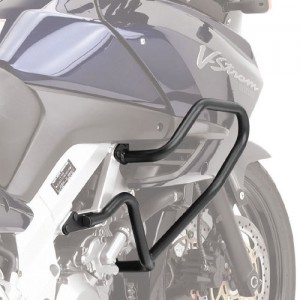Review by Olaf Wolff
[This Givi Motorcycle Engine Guards Review was originally published in the July 2006 issue of Rider magazine]

Motorcycle mechanics are often jaded when it comes to opinions regarding motorcycle aesthetics. Knowing that, I still felt the urge to ask the mechanic doing the 600-mile service on my new Suzuki 650 V-Strom his opinion on engine guards.
He rides a V-Strom 1000, so he gave me kudos for choosing the 650, but felt free nonetheless to express his disdain for pretty much anything aftermarket. So, I thought, I’ll install the Givi motorcycle engine guards, but if I don’t like them for any reason I’ll just take them off. Halfway through the installation I was convinced they were on for the duration.
Installing the Givi engine guards is a piece of cake, if you don’t let the weakly written instructions and pictures of a guard for a different motorcycle distract you.
The actual procedure is fairly basic, but as they use engine-mounting bolts, be certain to install one side first before doing the other. Remove the fairing trim right below the gas tank (one 4mm hex bolt and two snap fasteners). Line up the guard and the rest is self-explanatory—two 6mm engine hex bolts on top, two on the bottom.
Save the OEM bolts should you decide to ever remove the guards, but you’ll need to use the longer supplied ones to install the guards properly. At this point just snug up the four new hex bolts on the one side before moving to the other side. Because of the angled bends in the guards and slight variables in the welds, it’s necessary to leave the guards only lightly tightened, so there’s play.
With both sides freely installed, position the spacer and the “nipple”—which incidentally is the only term in the instructions that’s given a translation (it fits between the two open ends of the guards that meet just above the oil cooler)—and begin to tighten the single 6mm bracket screw, pulling the two sides together. Then go back and tighten the four engine hex bolts on each side.
Here’s an important tip: The heads of these bolts can begin to strip before the bolts completely firm up. This left me feeling less than confident, since I had to go by feel after making that discovery on the first bolt.
With that said, the guards feel secure as they are. They add aggressive styling to the bike’s profile, and from all indications, they’ll do exactly what they’re supposed to do, should I actually ever need them. They’re labeled engine guards, though clearly, they’ll protect the gas tank as well.
In conclusion, Givi makes a very good set of engine guards for $163. The functionality and execution of the design is apparent. The lack of passable instructions isn’t really a problem—for my purposes a good exploded illustration and some torque specs would substitute just fine. But it’s too bad that a decision to go with lower-quality fasteners slightly besmirches what is otherwise a complete engine-guard package.







